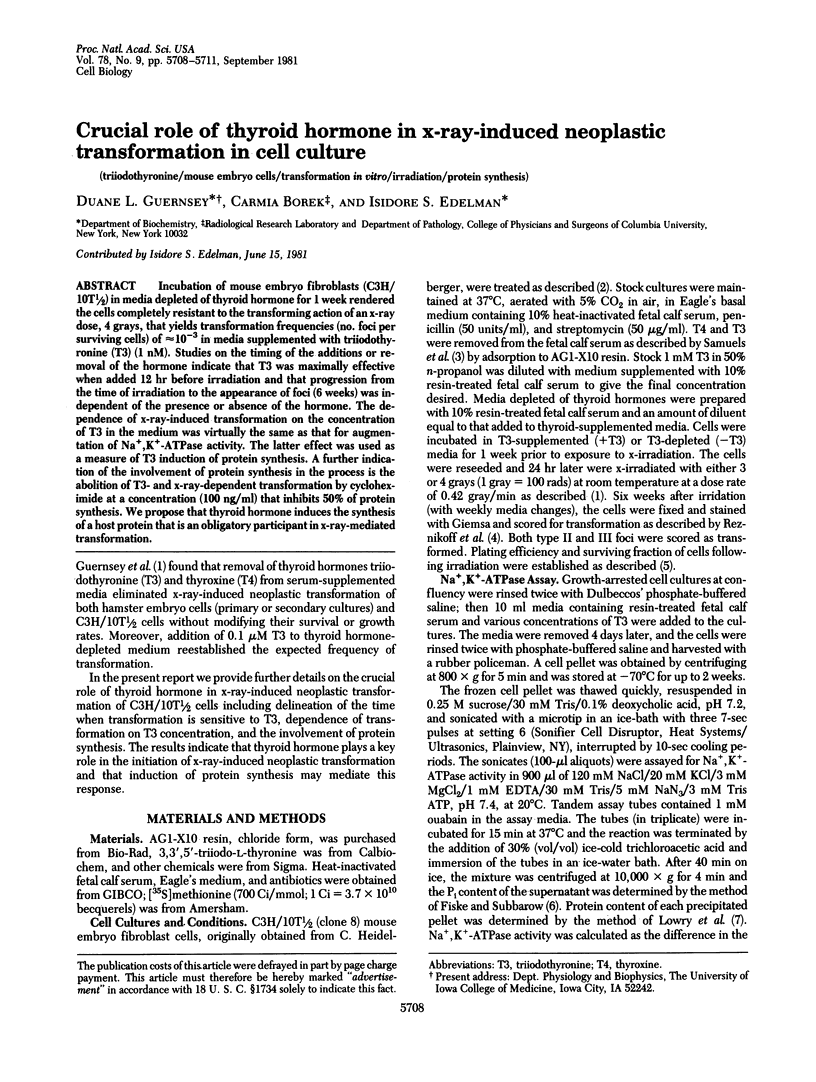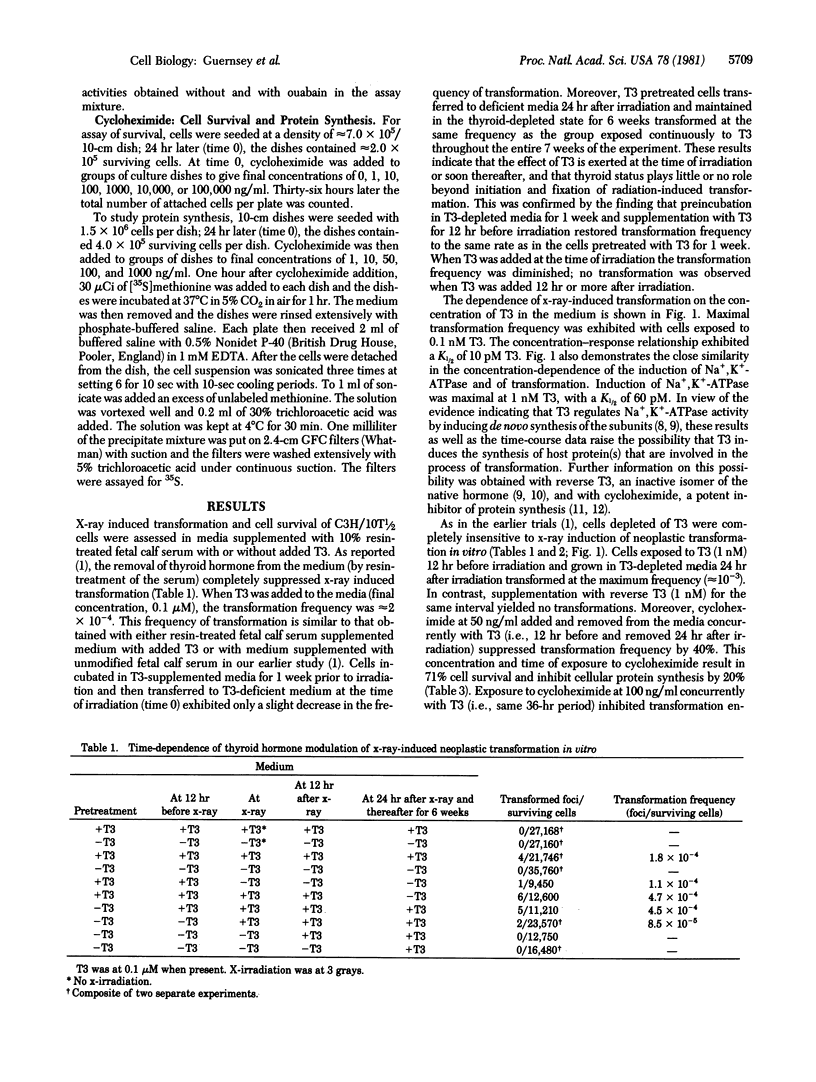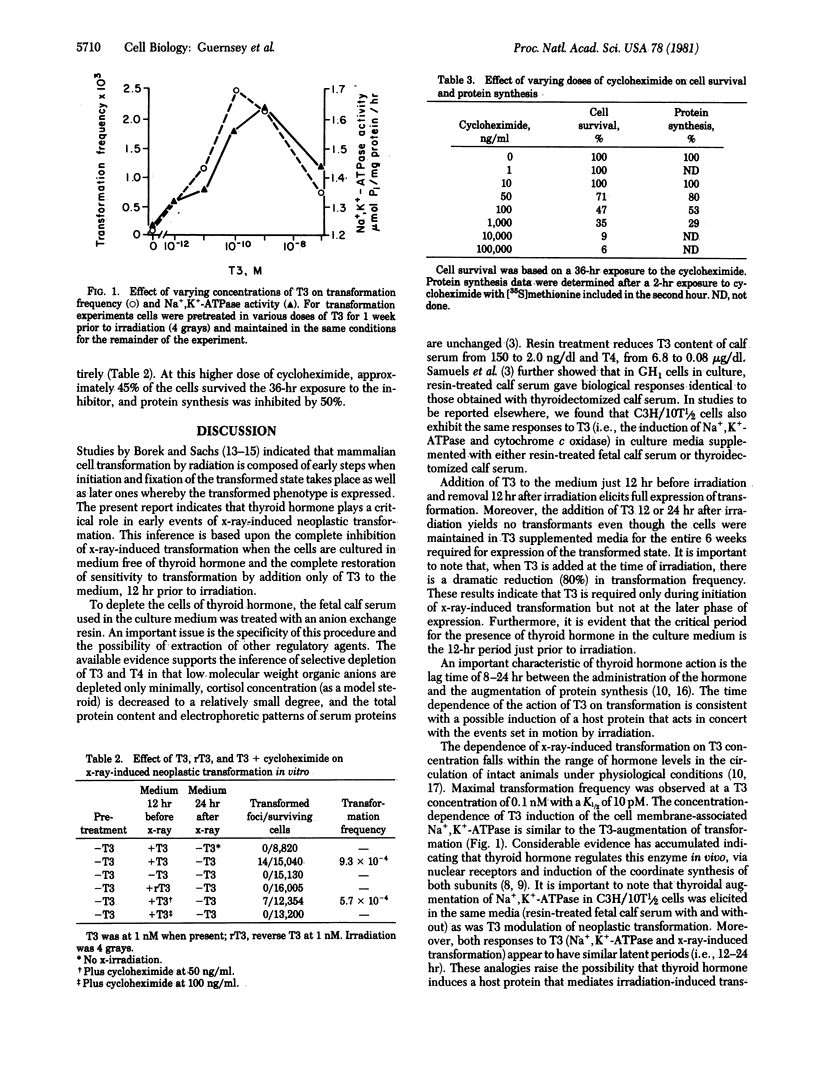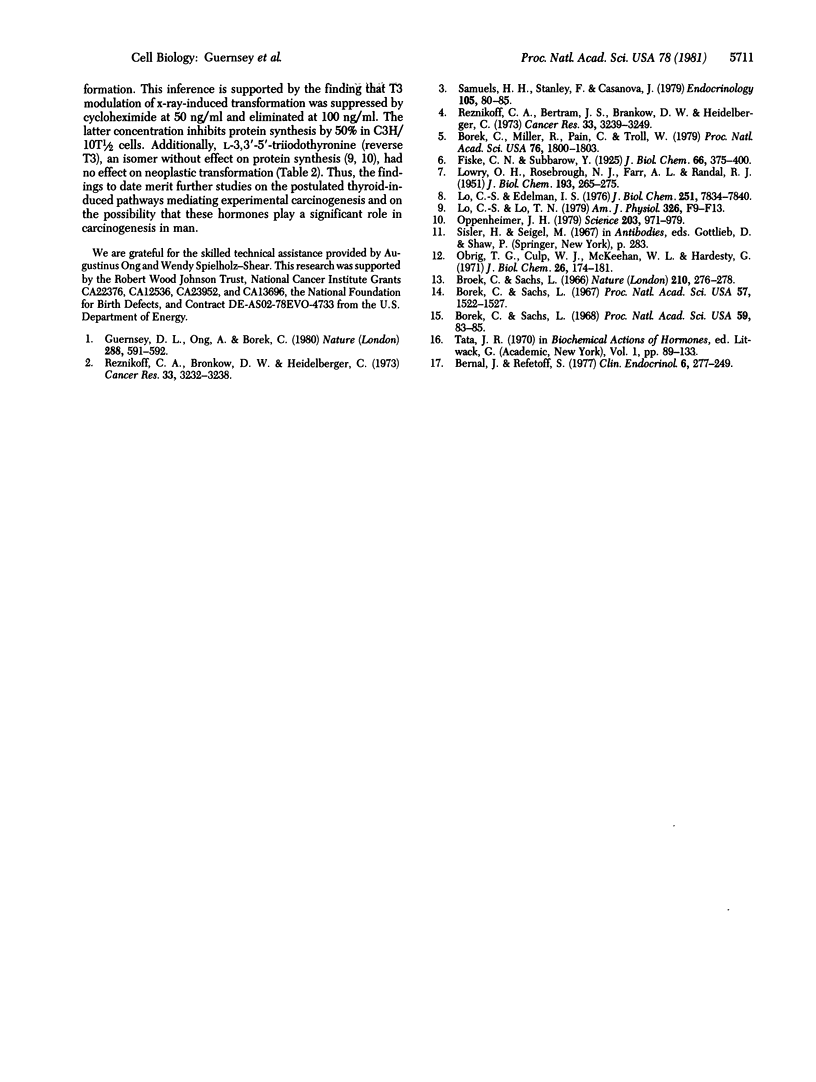Abstract
Incubation of mouse embryo fibroblasts (C3H/10T1/2) in media depleted of thyroid hormone for 1 week rendered the cells completely resistant to the transforming action of an x-ray dose, 4 grays, that yields transformation frequencies (no. foci per surviving cells) of approximately 10(-3) in media supplemented with triiodothyronine (T3) (1 nM). Studies on the timing of the additions or removal of the hormone indicate that T3 was maximally effective when added 12 hr before irradiation and that progression from the time of irradiation to the appearance of foci (6 weeks) was independent of the presence or absence of the hormone. The dependence of x-ray-induced transformation on the concentration of T3 in the medium was virtually the same as that for augmentation of Na+,K+-ATPase activity. The latter effect was used as a measure of T3 induction of protein synthesis. A further indication of the involvement of protein synthesis in the process is the abolition of T3- and x-ray-dependent transformation by cycloheximide at a concentration (100 ng/ml) that inhibits 50% of protein synthesis. We propose that thyroid hormone induces the synthesis of a host protein that is an obligatory participant in x-ray-mediated transformation.
Full text
PDF



Selected References
These references are in PubMed. This may not be the complete list of references from this article.
- Bernal J., Refetoff S. The action of thyroid hormone. Clin Endocrinol (Oxf) 1977 Mar;6(3):227–249. doi: 10.1111/j.1365-2265.1977.tb03319.x. [DOI] [PubMed] [Google Scholar]
- Borek C., Miller R., Pain C., Troll W. Conditions for inhibiting and enhancing effects of the protease inhibitor antipain on x-ray-induced neoplastic transformation in hamster and mouse cells. Proc Natl Acad Sci U S A. 1979 Apr;76(4):1800–1803. doi: 10.1073/pnas.76.4.1800. [DOI] [PMC free article] [PubMed] [Google Scholar]
- Borek C., Sachs L. Cell susceptibility to transformation by x-irradiation and fixation of the transformed state. Proc Natl Acad Sci U S A. 1967 May;57(5):1522–1527. doi: 10.1073/pnas.57.5.1522. [DOI] [PMC free article] [PubMed] [Google Scholar]
- Borek C., Sachs L. In vitro cell transformation by x-irradiation. Nature. 1966 Apr 16;210(5033):276–278. doi: 10.1038/210276a0. [DOI] [PubMed] [Google Scholar]
- Borek C., Sachs L. The number of cell generations required to fix the transformed state in X-ray-induced transformation. Proc Natl Acad Sci U S A. 1968 Jan;59(1):83–85. doi: 10.1073/pnas.59.1.83. [DOI] [PMC free article] [PubMed] [Google Scholar]
- Guernsey D. L., Ong A., Borek C. Thyroid hormone modulation of X ray-induced in vitro neoplastic transformation. Nature. 1980 Dec 11;288(5791):591–592. doi: 10.1038/288591a0. [DOI] [PubMed] [Google Scholar]
- LOWRY O. H., ROSEBROUGH N. J., FARR A. L., RANDALL R. J. Protein measurement with the Folin phenol reagent. J Biol Chem. 1951 Nov;193(1):265–275. [PubMed] [Google Scholar]
- Lo C. S., Edelman I. S. Effect of triiodothyronine on the synthesis and degradation of renal cortical (Na+ + k+)-adenosine triphosphatase. J Biol Chem. 1976 Dec 25;251(24):7834–7840. [PubMed] [Google Scholar]
- Lo C. S., Lo T. N. Time course of the renal response to triiodothyronine in the rat. Am J Physiol. 1979 Jan;236(1):F9–13. doi: 10.1152/ajprenal.1979.236.1.F9. [DOI] [PubMed] [Google Scholar]
- Obrig T. G., Culp W. J., McKeehan W. L., Hardesty B. The mechanism by which cycloheximide and related glutarimide antibiotics inhibit peptide synthesis on reticulocyte ribosomes. J Biol Chem. 1971 Jan 10;246(1):174–181. [PubMed] [Google Scholar]
- Oppenheimer J. H. Thyroid hormone action at the cellular level. Science. 1979 Mar 9;203(4384):971–979. doi: 10.1126/science.218285. [DOI] [PubMed] [Google Scholar]
- Reznikoff C. A., Bertram J. S., Brankow D. W., Heidelberger C. Quantitative and qualitative studies of chemical transformation of cloned C3H mouse embryo cells sensitive to postconfluence inhibition of cell division. Cancer Res. 1973 Dec;33(12):3239–3249. [PubMed] [Google Scholar]
- Reznikoff C. A., Brankow D. W., Heidelberger C. Establishment and characterization of a cloned line of C3H mouse embryo cells sensitive to postconfluence inhibition of division. Cancer Res. 1973 Dec;33(12):3231–3238. [PubMed] [Google Scholar]
- Samuels H. H., Stanley F., Casanova J. Depletion of L-3,5,3'-triiodothyronine and L-thyroxine in euthyroid calf serum for use in cell culture studies of the action of thyroid hormone. Endocrinology. 1979 Jul;105(1):80–85. doi: 10.1210/endo-105-1-80. [DOI] [PubMed] [Google Scholar]


